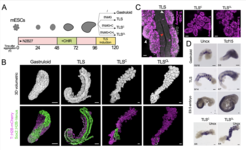A 3D model for mid-gestational development in a dish

Axial elongation leading to formation of the trunk and tail is a reiterative process of continued generation of mainly mesodermal and neural cell lineages from neuro-mesodermal progenitors (NMPs). This is followed by dorso-ventral patterning guided by the organizing centers, the node and notochord. These processes are characterized by extensive growth, multiple lineage decisions and morphogenetic events. Naturally, the dynamics of these processes in space and time are difficult to study in vivo in mammals. A robust in vitro culture system that reliably and reproducibly mimics mid-gestational mouse development would overcome these limitations and help to reduce animal experiments.
Recently, we succeeded in generating 3D structures that recapitulate trunk development (we call them trunk-like structures, TLS). TLS induce all three germ layers in a spatially organized manner reminiscent of their in vivo counterpart, as shown by extensive characterization of TLS comprising scRNA-seq, in collaboration with the Meissner department. Importantly, TLS contain cells co-expressing Brachyury and Sox2 at their posterior end, resembling neuro-mesodermal progenitors. These cells form paraxial mesoderm and neuroectoderm, developing into somites and a neural tube, respectively, at an embryo-like pace (Fig. 1). The TLS system is a powerful platform for studying the morphogenetic changes and lineage decisions, underlying mid-gestational development in the culture dish. We work on further improving TLSs by trying to induce a node and notochord as well as lateral mesoderm.
